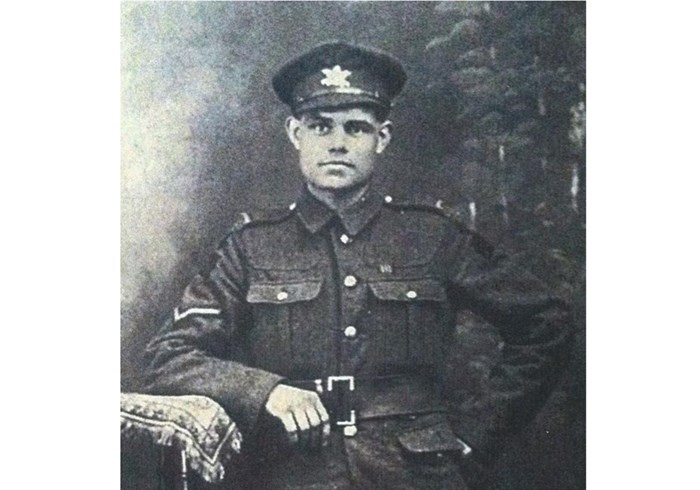
George "Black Jack'' Vowel is seen in an undated handout photo. Vowel had the Spanish flu while travelling on a troop ship called the HMS Monas Queen from France to England and described the experience in a letter dated March 24, 1919. His granddaughter Jacqueline Carmichael has dedicated a chapter of her new book "'Heard Amid the Guns: True Stories from the Western Front, 1914-1918" to the parallels between the 1919 flu and COVID-19 pandemics.
Image Credit: THE CANADIAN PRESS/HO-Jacqueline Carmichael
November 06, 2020 - 9:00 PM
Stirred by the onset of COVID-19, Jacqueline Carmichael combed through faded letters from the First World War for mentions of the Spanish flu, finding haunting similarities to today as lives were changed then by the pandemic.
For the author, the exchanges preserved in paper between soldiers and their families towards the end of the war as the Spanish flu loomed over celebrations are particularly poignant.
In her new book, 'Heard Amid the Guns: True Stories from the Western Front, 1914-1918,' she dedicated a chapter to the parallels between the two pandemics.
After being "curled up in a ball from being depressed" and binge-watching Friends on Netflix, she said she began reworking her book after it had already been submitted.
The importance of the Spanish flu didn't register with her until the COVID-19 pandemic, said Carmichael, who lives in Port Alberni, B.C.
"We hear pandemic and we're like 'Oh, I think I saw something about that on Downton Abbey,' " she said in a recent interview.
"But the fact is that 100 years ago, our forebearers were dealing with this very thing."
That's when she realized that among the many afflictions her grandfather George "Black Jack'' Vowel suffered during the war was what he called the grippe, another name for the flu.
"I started going back through the letters specifically looking for references to flu and the grippe and the illnesses, and by gum, it was all there in black and white. I just had to look at it differently."
Her grandfather had the flu while travelling on a troop ship called the HMS Monas Queen from France to England and described the experience in a letter dated March 24, 1919.
"We pulled out of the harbor loaded to the scuppers with soldiers. The seas were running mountain high and a man's size gale blowing," reads the letter on yellow, crumbling paper.
"I had a very bad dose of the grippe and managed to get on the second deck wedged between two steam pipes and never moved all the fourteen hours on board. Fully three quarters of the men were seasick."
Tim Cook, a historian at the Canadian War Museum, said it is difficult to find the exact number of soldiers who died from the flu. A medical history book puts it at 776 but that number is disputed, and the actual death toll is considered to be much higher, he added.
The disease made its way across the country as the returning men travelled by train, he said.
"It really worked its way into every city, every town, almost every village in the country."
Cook sees some obvious parallels between the Spanish flu and COVID-19, such as closing down schools, theatres and churches, but also a stronger discussion about public health.
One of the key legacies of the disease was the creation of the Department of Health in 1919 in response to the Spanish flu, he said.
Prof. Stephen Davies of Vancouver Island University, a historian who is also director of the Canadian Letters and Images Project, said references to the Spanish flu are from letters written in camps in England or France as soldiers ask about the disease in Canada.
"It's just mostly single lines scattered through the letters but there is nothing substantive focusing on the flu," he said in an email. "They are certainly well aware of it though."
One letter from William Stares dated July 21, 1918, described symptoms of the flu.
"Severe headache, partial loss of legs, aches and pains all over, and feverish," it says. "For one week I just gazed at the ceiling, counting the flies, working out imaginary patterns on the paintwork, going through some of the battles again, (in my mind) killing Germans by the thousands. The lad in the next bed thought it safer underneath the bed. (suppose I was delirious) I had to laugh when he told me about it."
Carmichael said the letters show that most of the spread came after Armistice Day because people couldn't "contain themselves" celebrating the end of the war with parties and parades.
"Armistice was a super-spreader event, because these people were so crowded and then, of course, once they started going home, they were crowded into troop ships, which exposed them further," she said.
Soldier Robert Shortreed of Guelph, Ont., captured the mood in Paris in a letter written the day after the armistice to his mother describing streets "crazy with joy" and "impassable for people."
"Today is going to be almost as bad. Flags are to be seen everywhere. The French way of showing their joy is to kiss everyone and few people escaped it yesterday. Of course, the soldiers came in for their share."
Reading the letters that mention the Spanish flu, Carmichael said she feels "another kind of empathy" with soldiers and their families because they dealt with something that the world is going through now.
"They could dodge the shells, and they could run between the bullets and somehow make it through, and still be taken down by a virus," she said.
"It was probably one of the biggest tragedies of the war."
This report by The Canadian Press was first published Nov. 6, 2020.
News from © The Canadian Press, 2020